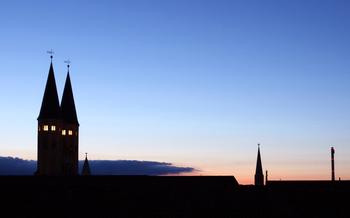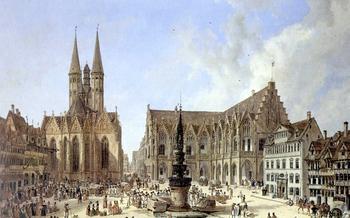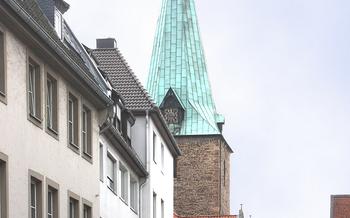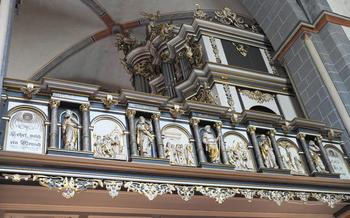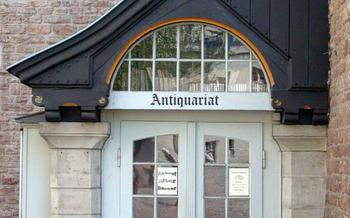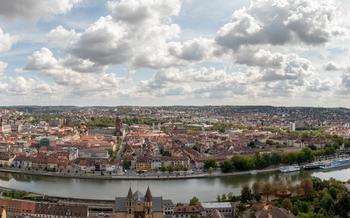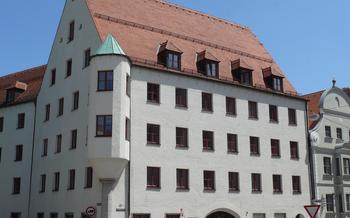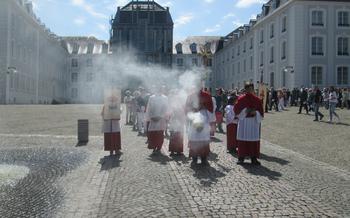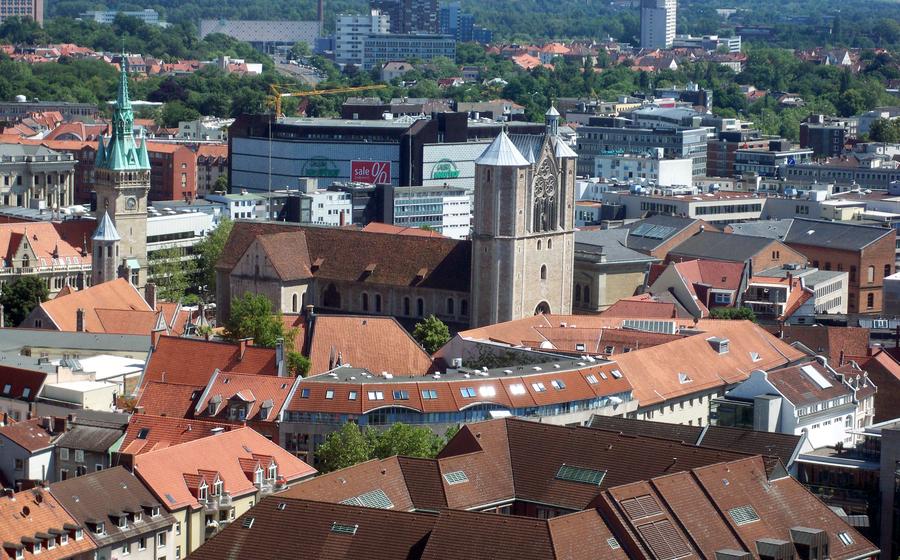
Braunschweiger Dom (St. Blasius Cathedral)
- A Gothic Masterpiece in the Heart of Braunschweig
- Stepping into the Past: The History of Braunschweiger Dom
- Exploring the Architectural Marvel
- A Journey Through the Interior
- Unveiling the Sacred Artworks
- The Lion Monument: A Symbol of Strength and Courage
- A Place of Worship and Pilgrimage
- The Braunschweiger Dom as a Cultural Venue
- Guided Tours and Educational Programs
- Events and Festivals at the Braunschweiger Dom
- Practical Information for Visitors
- Surrounding Attractions and Activities
- Local Legends and Folklore
- Contemporary Art and Installations:
- Insider Tip: Hidden Gem in the Cathedral
A Gothic Masterpiece in the Heart of Braunschweig
In the heart of the historic city of Braunschweig, nestled amidst cobblestone streets and half-timbered houses, stands the Braunschweiger Dom, a stunning testament to Gothic architectural prowess. With its soaring spires piercing the sky and intricate carvings adorning its facade, the cathedral exudes an aura of grandeur and spirituality that has captivated visitors for centuries.
The Braunschweiger Dom, also known as St. Blasius Cathedral, holds a significant place in the religious and cultural heritage of Braunschweig. Founded in the 12th century, the cathedral has witnessed the passage of time, serving as a place of worship, pilgrimage, and community gathering. Its imposing presence dominates the cityscape, symbolizing the city's rich history and deep-rooted faith.
The cathedral's exterior is a symphony of Gothic artistry, featuring intricate carvings, delicate tracery, and majestic buttresses that lend a sense of lightness and grace to its massive structure. The twin towers, reaching towards the heavens, create a striking silhouette against the backdrop of the city's skyline.
Stepping inside the Braunschweiger Dom is like stepping into a realm of awe and wonder. The soaring nave, with its ribbed vaults and elegant arcades, creates a sense of vastness and majesty. The intricate stained-glass windows, depicting biblical scenes and the lives of saints, cast a kaleidoscope of colors, transforming the interior into a sacred space of light and beauty.
The Braunschweiger Dom is not merely an architectural marvel; it is also a treasure trove of religious art and symbolism. The stunning altarpieces, with their intricate carvings and vibrant colors, depict significant moments from the Bible, inviting visitors to contemplate their faith and the life of Christ.
The cathedral also houses a collection of medieval paintings, sculptures, and tapestries, each piece a testament to the artistic prowess of its time. These artworks, with their rich symbolism and iconography, provide a glimpse into the religious and cultural beliefs of the Middle Ages.
Overall, the Braunschweiger Dom stands as a testament to the enduring power of faith and the artistic genius of the Gothic era. It is a place where history, art, and spirituality converge, creating an awe-inspiring experience for visitors from all walks of life.
Stepping into the Past: The History of Braunschweiger Dom
The Braunschweiger Dom, with its rich history, is a testament to the architectural prowess and religious devotion of Braunschweig's past. Its foundation dates back to the 12th century when Henry the Lion, the powerful Duke of Saxony and Bavaria, envisioned a grand cathedral to rival the great Gothic structures of his time. Construction began in 1173, and over the following centuries, the cathedral underwent several phases of expansion and modification.
During the Middle Ages, the Braunschweiger Dom served as a spiritual and political center for the city. It was here that important religious ceremonies, such as coronations and baptisms, took place. The cathedral's treasury, which housed precious relics and artifacts, attracted pilgrims from across the region.
The Reformation, a pivotal event in European history, had a profound impact on the Braunschweiger Dom. In 1528, the city embraced Lutheranism, and the cathedral transitioned from a Catholic to a Protestant place of worship. This shift marked a significant change in the cathedral's rituals and practices, as well as its role in the community.
Throughout its history, the Braunschweiger Dom has faced challenges and undergone renovations. In the 17th century, a devastating fire caused extensive damage to the cathedral's interior. The subsequent restoration efforts, led by skilled craftsmen, preserved the Gothic character of the building while incorporating Baroque elements that reflected the changing artistic tastes of the time.
Today, the Braunschweiger Dom stands as a testament to the resilience and dedication of Braunschweig's people. Its rich history, intertwined with the city's own narrative, continues to captivate visitors and pilgrims alike, making it a beloved landmark that bridges the past and the present.
Exploring the Architectural Marvel
The Braunschweiger Dom stands as a testament to the architectural prowess of the Middle Ages. Its unique blend of Romanesque and Gothic styles creates a harmonious fusion of strength and elegance. The massive structure dominates the cityscape, its twin towers reaching towards the heavens like celestial beacons.
Inside, the cathedral's vast dimensions are awe-inspiring. The nave, with its towering height and graceful ribbed vaults, exudes a sense of grandeur and spirituality. The intricate carvings that adorn the pillars and arches tell stories from the Bible and the lives of saints, bringing the scriptures to life in stone.
Notable features of the Braunschweiger Dom include the impressive flying buttresses, which provide structural support while creating a dramatic visual effect. The stained-glass windows, with their vibrant colors and intricate designs, cast a warm glow upon the interior, transforming the cathedral into a kaleidoscope of light.
The architectural details of the Braunschweiger Dom are rich in symbolism and hidden meanings. The number three, representing the Holy Trinity, is echoed throughout the design, from the three towers to the three portals. The rose window on the western façade features intricate tracery that resembles a crown, symbolizing the heavenly kingdom.
Exploring the Braunschweiger Dom is a journey through time, art, and spirituality. Its architectural marvels tell a story of faith, devotion, and human ingenuity, inviting visitors to marvel at the enduring legacy of medieval craftsmanship.
A Journey Through the Interior
As you step inside the Braunschweiger Dom, you are greeted by a breathtaking spectacle of architectural grandeur and artistic mastery. The awe-inspiring nave, with its soaring height and elegant proportions, creates a sense of reverence and wonder. The intricate carvings that adorn the pillars and arches, along with the delicate tracery of the ribbed vaults, showcase the exceptional craftsmanship of medieval stonemasons.
The cathedral's interior is a treasure trove of medieval art and iconography. Intricate sculptures and reliefs depict biblical scenes and saints, while stunning stained-glass windows cast a kaleidoscope of colors onto the stone floor. Each window tells a story from the Bible or the lives of the saints, inviting visitors to contemplate their spiritual significance.
Two magnificent organs grace the cathedral's interior, each with its own unique history and sound. The older organ, known as the "Domorgel," dates back to the 16th century and is renowned for its rich tones and intricate carvings. The newer organ, installed in the 19th century, is equally impressive, with its powerful sound and modern design.
The Braunschweiger Dom is also home to several tombs and memorials of notable figures from Braunschweig's history. Among them is the tomb of Henry the Lion, the founder of the city, which features a life-size bronze effigy of the duke. Other notable tombs include those of Otto IV, the only German emperor to be crowned in Rome, and his wife, Beatrice of Swabia.
Unveiling the Sacred Artworks
The Braunschweiger Dom is home to a remarkable collection of sacred artworks that captivate visitors with their beauty, symbolism, and historical significance. The intricate altarpieces, adorned with gold leaf and vibrant colors, depict scenes from the Bible and the lives of saints, serving as a testament to the skill and devotion of medieval artisans.
The cathedral's collection of medieval paintings, sculptures, and tapestries further enriches the visual experience. Each artwork tells a story, conveying religious teachings and offering a glimpse into the spiritual beliefs of the time. The symbolism and iconography depicted in these works of art invite visitors to contemplate their deeper meanings and connections to the Christian faith.
The interplay between art and faith within the Braunschweiger Dom creates a profound sense of spirituality and awe. The artworks serve as visual aids, helping worshippers to connect with the divine and to deepen their understanding of the Christian message. The harmonious blend of art and architecture within the cathedral creates a sacred space that encourages contemplation, prayer, and reflection.
The Lion Monument: A Symbol of Strength and Courage
The Brunswick Lion, a majestic symbol of Braunschweig, stands guard in front of the Braunschweiger Dom, embodying strength, courage, and civic pride.
Cast in bronze in 1166 during the reign of Henry the Lion, Duke of Saxony and Bavaria, the Brunswick lion is one of the oldest and most iconic sculptures in Germany. Its imposing size, intricate details, and powerful presence have made it a beloved landmark and a symbol of the city's rich history and heritage.
Legends and myths surround the Brunswick lion, adding to its mystique and cultural significance.
One tale suggests that the lion was created to commemorate Henry the Lion's victory over a ferocious lion that terrorized the region. Another legend speaks of the lion's magical powers, claiming that it can grant wishes to those who touch its paws.
The Brunswick lion has played a significant role in local traditions and festivals, becoming an integral part of the city's identity.
During the annual Braunschweig Lion Festival, the lion is paraded through the streets, accompanied by music, dancing, and celebrations. The lion also features prominently in the city's coat of arms and flag, further solidifying its status as a symbol of Braunschweig.
Over the centuries, the Brunswick lion has undergone several restorations and renovations, ensuring its preservation as a cherished cultural treasure.
In 1874, the lion was moved to its current location in front of the Braunschweiger Dom, where it continues to captivate visitors with its grandeur and symbolism, standing as a testament to Braunschweig's rich history and enduring civic pride.
A Place of Worship and Pilgrimage
The Braunschweiger Dom holds a profound religious significance as a pilgrimage site. For centuries, pilgrims have journeyed to this sacred place to seek spiritual fulfillment and pay homage to the relics of saints and martyrs enshrined within its walls. The cathedral's reputation as a pilgrimage destination dates back to the Middle Ages when it became a popular stop along the Via Regia, a significant trade and pilgrimage route that connected Eastern and Western Europe.
Pilgrims from all walks of life, from humble peasants to noblemen, traveled to the Braunschweiger Dom to seek divine intervention, repent for their sins, or express gratitude for answered prayers. The cathedral's impressive collection of relics, including the bones of St. Blasius, St. John the Baptist, and other revered figures, further enhanced its reputation as a holy site.
Within the cathedral, pilgrims would engage in various religious rituals and devotions. They would pray before the altars, light candles, and offer votive offerings. The act of pilgrimage itself was seen as a transformative experience, a journey that brought pilgrims closer to God and provided an opportunity for spiritual renewal.
Even today, the Braunschweiger Dom continues to attract pilgrims from around the world. They come to seek solace, guidance, and a deeper connection with their faith. The cathedral's atmosphere of reverence and devotion, coupled with its rich history and stunning architecture, creates a powerful and moving experience for all who visit.
The Braunschweiger Dom as a Cultural Venue
Beyond its religious significance, the Braunschweiger Dom serves as a vibrant cultural venue, hosting a variety of events and concerts that showcase the cathedral's exceptional acoustics and ambiance. The soaring interior and intricate architectural details create a unique and awe-inspiring setting for musical performances, choral concerts, and organ recitals. Renowned musicians and ensembles from around the world grace the stage of the cathedral, filling the air with enchanting melodies and harmonies that resonate within the sacred space.
The Braunschweiger Dom's rich history and spiritual atmosphere provide a profound backdrop for cultural events that blend art, music, and spirituality. Visitors can experience the interplay of sacred and secular as they witness performances that range from classical masterpieces to contemporary compositions. The cathedral's acoustics, with its long reverberation time and clear tones, enhance the musical experience, allowing the music to envelop the audience and transport them to a realm of pure sound.
Notable cultural events held within the Braunschweiger Dom include the annual "Braunschweiger Domkonzerte" series, which features a diverse lineup of classical concerts, as well as special events such as the "Nacht der Kirchen" (Night of the Churches), where the cathedral opens its doors for an evening of music, art exhibitions, and guided tours. These events not only celebrate the cultural heritage of Braunschweig but also provide a platform for emerging artists and musicians to showcase their talents.
Attending a cultural event at the Braunschweiger Dom offers visitors a unique opportunity to experience the cathedral's grandeur and spiritual essence while immersing themselves in the world of music and art. The blending of history, architecture, and culture creates a truly unforgettable experience that resonates long after the final note has faded.
Guided Tours and Educational Programs
The Braunschweiger Dom offers guided tours in various languages, providing visitors with an in-depth understanding of its history, architecture, and significance. Knowledgeable guides lead visitors through the cathedral, highlighting its most notable features and sharing fascinating stories and anecdotes.
These tours delve into the intricate details of the cathedral's construction, exploring the unique blend of Romanesque and Gothic styles and explaining the symbolism behind the architectural elements. Visitors can learn about the historical events that have shaped the cathedral and the impact of the Reformation on its role as a religious center.
Educational programs are also available for students and visitors of all ages. These programs provide an engaging and interactive way to learn about the Braunschweiger Dom's history, art, and architecture. Through hands-on activities, workshops, and interactive presentations, participants can gain a deeper appreciation for this magnificent cathedral.
Whether you choose to explore the Braunschweiger Dom through a guided tour or an educational program, you'll leave with a newfound understanding and appreciation for this architectural masterpiece and its enduring legacy.
Events and Festivals at the Braunschweiger Dom
The Braunschweiger Dom is not only a place of worship and pilgrimage but also a vibrant venue for cultural events and festivals throughout the year. These events showcase the cathedral's rich history, stunning architecture, and enduring cultural significance.
One of the most notable events is the annual Braunschweiger Dom Music Festival, which features a series of concerts and performances by renowned musicians and ensembles from around the world. The cathedral's exceptional acoustics and ambiance create an immersive experience for music lovers, who can enjoy classical, sacred, and contemporary music within the hallowed walls of the Dom.
Major religious festivals, such as Christmas, Easter, and Pentecost, are celebrated with special services, processions, and musical performances at the cathedral. These events draw large crowds of worshippers and visitors who come to experience the spiritual atmosphere and witness the traditions associated with each festival.
In addition, the Braunschweiger Dom hosts a variety of special events and concerts throughout the year. These events range from organ concerts and choral performances to art exhibitions and lectures. Visitors can check the cathedral's website or contact the visitor center for information on upcoming events and festivals.
Attending an event or festival at the Braunschweiger Dom is a wonderful opportunity to experience the cathedral's vibrant cultural atmosphere and engage with the local community. These events offer a unique blend of art, music, and spirituality, creating lasting memories for visitors and locals alike.
Practical Information for Visitors
Planning a visit to the Braunschweiger Dom is essential to make the most of your experience. The cathedral is open to the public from Monday to Saturday, with slightly shorter hours on Sundays and holidays. Admission fees are reasonable, and there are discounts for students, seniors, and groups. Visitors can purchase tickets at the entrance or book them online to avoid queues.
The Braunschweiger Dom is accessible to visitors with disabilities, with ramps and elevators available to navigate the different levels. However, it's advisable to inform the staff in advance if you require special assistance.
Respectful behavior is expected within the cathedral, as it is a sacred place of worship. Visitors are requested to dress appropriately, avoid loud noises, and refrain from taking flash photography. Guided tours in various languages are available for those who wish to delve deeper into the history and significance of the cathedral.
To enhance your visit, consider arriving a little early to soak in the serene atmosphere before the crowds arrive. If you're short on time, focus on the highlights, such as the nave, the altarpieces, and the lion monument. For a more comprehensive experience, plan to spend at least an hour exploring the cathedral's interior and exterior.
Surrounding Attractions and Activities
A visit to the Braunschweiger Dom can be easily combined with other sightseeing opportunities in the city of Braunschweig. A short walk from the cathedral, the Altstadtmarkt, the heart of the historic city center, invites you to explore its charming medieval architecture, colorful half-timbered houses, and bustling atmosphere. Here, you can find a variety of shops, restaurants, and cafes to cater to your needs.
Just a stone's throw away from the Altstadtmarkt, Dankwarderode Castle stands as a testament to Braunschweig's rich history. This 12th-century castle once served as the residence of the dukes of Brunswick-Lüneburg and now houses the Dankwarderode Museum, home to a collection of medieval art, artifacts, and treasures. The museum offers a glimpse into the lives of the former rulers and the cultural heritage of the region.
For those interested in delving deeper into the history and culture of Braunschweig, the Brunswick State Museum is a must-visit. Located near the Braunschweiger Dom, the museum houses a vast collection of exhibits, ranging from prehistoric finds to contemporary art. Highlights include the Egyptian collection, the medieval art section, and the gallery of modern masters.
To make the most of your visit, consider following one of the suggested walking routes or itineraries that guide you through the city center, showcasing its architectural landmarks, hidden gems, and picturesque canals. These routes allow you to explore the city at your own pace, taking in the sights and soaking up the vibrant atmosphere.
As you wander through Braunschweig, be sure to savor the local cuisine at one of the many restaurants or cafes. From traditional German dishes to international flavors, there's something to satisfy every palate. Don't forget to sample the local specialty, the Braunschweiger Mumme, a dark beer with a rich history dating back to the Middle Ages.
With its rich cultural heritage, stunning architecture, and vibrant atmosphere, Braunschweig offers a wealth of attractions and activities to complement your visit to the Braunschweiger Dom. Take the opportunity to explore this charming city and discover its many hidden treasures.
Local Legends and Folklore
The Braunschweiger Dom and its long history have attracted a wealth of myths and legends that have become an integral part of the city's cultural heritage. One captivating tale speaks of a mysterious monk who was said to possess the power to heal the sick and perform miracles. According to legend, this monk lived in the cathedral during the Middle Ages and dedicated his life to helping those in need. Visitors can still see the monk's tomb within the cathedral, where pilgrims often leave offerings in hopes of receiving his blessings.
Another beloved legend revolves around the Brunswick lion, a symbol of strength and courage that stands proudly in front of the cathedral. It is said that the lion was once a living creature that was miraculously transformed into stone to protect the city from harm. The lion's imposing presence and its legendary origins have made it a beloved figure among locals and visitors alike, inspiring countless stories and traditions.
By delving into the local legends and folklore surrounding the Braunschweiger Dom, visitors can gain a deeper understanding of the city's rich history and cultural identity. These tales bring the cathedral to life, adding a layer of enchantment and mystery to its already remarkable presence.
Contemporary Art and Installations:
The Braunschweiger Dom is not only a testament to the past but also a vibrant space for contemporary art and installations. In recent years, the cathedral has embraced modern artistic expression, creating a dialogue between the historic and the contemporary. Temporary exhibitions and site-specific installations challenge traditional perceptions and invite visitors to experience the cathedral in new and unexpected ways. These artistic interventions breathe new life into the ancient space, allowing visitors to appreciate the interplay between past and present.
One striking example is the installation "Lichtgestalten" by the artist collective "raumlaborberlin." The installation features a series of glowing, translucent figures suspended in the nave of the cathedral. These ethereal figures seem to float effortlessly, creating an otherworldly atmosphere that transforms the sacred space into a canvas for artistic contemplation. The interplay of light and shadow creates a mesmerizing effect, drawing visitors' attention to the intricate details of the cathedral's architecture while simultaneously highlighting the transience of time.
Another notable contemporary artwork is the "Sound Chapel" created by the artist duo "Pfadfinderei." This interactive sound installation invites visitors to experience the cathedral's acoustics in a unique and immersive way. Through a series of strategically placed speakers and sensors, visitors can create their own soundscapes by moving through the space. The interplay between the cathedral's acoustics and the visitors' movements results in a mesmerizing auditory experience that encourages a deeper connection with the space.
These contemporary art installations not only enhance the visitor experience but also serve as a reminder that the Braunschweiger Dom is a living, breathing space that continues to evolve with the times. By embracing modern artistic expression, the cathedral invites visitors to experience its rich history and cultural significance in new and thought-provoking ways.
Insider Tip: Hidden Gem in the Cathedral
Amidst the grandeur of the Braunschweiger Dom, there lies a hidden gem that often goes unnoticed by visitors. Tucked away in a secluded corner of the cathedral, behind a discreet doorway, is a small, unassuming chapel known as the Marienkapelle (St. Mary's Chapel). This intimate space holds a treasure that is both poignant and awe-inspiring: a beautifully preserved 14th-century fresco depicting the life of the Virgin Mary.
The fresco, with its vibrant colors and intricate details, narrates the story of Mary's journey from her Annunciation to her Coronation in Heaven. Each scene is rendered with exquisite skill, capturing the emotions and expressions of the characters with remarkable realism. The chapel itself exudes an aura of tranquility, inviting visitors to pause and reflect on the profound significance of Mary's role in Christian faith.
While the Braunschweiger Dom is renowned for its architectural magnificence, the Marienkapelle offers a glimpse into its more personal and spiritual side. It is here, in this hidden sanctuary, that visitors can discover a hidden gem that speaks to the enduring power of art, faith, and the human spirit.
